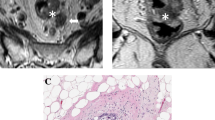Abstract
Background and aims
Evidence has shown that a positive resection margin (R1) is a key determinant of subsequent local recurrence and a poor prognostic factor in rectal cancer. The aim of this study was to evaluate the outcomes and prognosticators in patients with R1 resection of rectal cancer.
Material and methods
Retrospective study of all patients operatively managed within our institution between April 2008 and April 2013 for rectal cancer. Baseline demographics and multiple outcome measures recorded. Overall survival (OS), disease-free survival (DFS) and recurrence were the primary outcome measures.
Results
Overall, there were 306 primary rectal cancers. Seventy-six percent were grade T3/4 tumours. OS was 30 months. R1 rate was 16 % (48 patients). Thirty-one patients underwent APR and 17 AR. In patients who responded to neoadjuvant chemotherapy (NAC), overall survival was 55 months, with no extramural venous invasion (EMV) seen in this cohort. In non-responders OS was 29 months, with EMV in 48 %. In patients who did not receive NAC, OS was 23 months, with EMV in 74 %. EMV is a strong predictor for poor survival following R1 (p = 0.001). We also found a correlation between number of positive nodes and OS/DFS (p = 0.004).
Conclusions
In this small cohort of patients with R1 positive rectal cancers, response to NAC is the strongest predictor of poor overall and disease-free survival. In patients who respond to NAC, OS and DFS has been shown to be positive, with a reduced rate of EMV.



Similar content being viewed by others
References
Cancer Research UK Bowel. Cancer statistics http://www.cancerresearchuk.org/health-professional/cancer-statistics/statistics-by-cancer-type/bowel-cancer#heading-One. Assessed 21 Oct 2015.
Bhangu A, Beynon J, Brown G, Chang G, Das P, Desai A et al. 2013 Consensus statement on the multidisciplinary management of patients with recurrent and primary rectal cancer beyond total mesorectal excision planes. 100:1009–1014
Luna-Pérez P, Bustos-Cholico E, Alvarado I, Maffuz A, Rodríguez-Ramírez S, Gutiérrez de la Barrera M et al (2005) Prognostic significance of circumferential margin involvement in rectal adenocarcinoma treated with preoperative chemoradiotherapy and low anterior resection. J Surg Oncol. United States 90:20–25
Bujko K, Rutkowski A, Chang GJ, Michalski W, Chmielik E, Kusnierz J (2012) Is the 1-cm rule of distal bowel resection margin in rectal cancer based on clinical evidence? A systematic review. Ann Surg Oncol United States 19:801–808
Debove C, Maggiori L, Chau A, Kanso F, Ferron M, and Panis Y. 2014 What happens after R1 resection in patients undergoing laparoscopic total mesorectal excision for rectal cancer? A study in 333 consecutive patients. Colorectal Dis 25
Mawdsley S, Glynne-Jones R, Grainger J, Richman P, Makris A, Harrison M et al (2005) Can histopathologic assessment of circumferential margin after preoperative pelvic chemoradiotherapy for T3-T4 rectal cancer predict for 3-year disease-free survival? Int J Radiat Oncol Biol Phys United States 63:745–752
Bhangu A, Ali SM, Cunningham D, Brown G, Tekkis P (2013) Comparison of long-term survival outcome of operative vs nonoperative management of recurrent rectal cancer. Colorectal Dis England 15:156–163
Bhangu A, Ali SM, Darzi A, Brown G, Tekkis P (2012) Meta-analysis of survival based on resection margin status following surgery for recurrent rectal cancer. Colorectal Dis. England 14:1457–1466
Birbeck KF, Macklin CP, Tiffin NJ, Parsons W, Dixon MF, Mapstone NP et al (2002) Rates of circumferential resection margin involvement vary between surgeons and predict outcomes in rectal cancer surgery. Ann Surg United States 235:449–457
Radcliffe A (2006) Can the results of anorectal (abdominoperineal) resection be improved: are circumferential resection margins too often positive? Colorectal Dis. England 8:160–167
Chambers W, Khan A, Waters R, Lindsey I, George B, Mortensen N et al (2010) Examination of outcome following abdominoperineal resection for adenocarcinoma in Oxford. Colorectal Dis. England 12:1192–1197
Rullier E, Denost Q, Vendrely V, Rullier A, Laurent C (2013) Low rectal cancer: classification and standardization of surgery. Dis Colon rectum United States 56:560–567
Fekete Z, Muntean A, Irimie A, Hica S, Resiga L, Todor N et al (2013) What is the significance of a microscopically positive resection margin in the curative-intent treatment of rectal adenocarcinoma? A retrospective study. J BUON Greece 18:989–995
Hyngstrom JR, Tzeng CW, Beddar S, Das P, Krishnan S, Delclos ME et al (2014) Intraoperative radiation therapy for locally advanced primary and recurrent colorectal cancer: ten-year institutional experience. J Surg Oncol United States 109:652–658
Tan J, Heriot AG, Mackay J, Van Dyk S, Bressel MA, Fox CD et al (2013) Prospective single-arm study of intraoperative radiotherapy for locally advanced or recurrent rectal cancer. J Med Imaging Radiat Oncol Australia 57:617–625
Platell C, Spilsbury K (2014) Influence of local recurrence on survival in patients with rectal cancer. ANZ J Surg Australia 84:85–90
Simpson GS, Eardley N, McNicol F, Healey P, Hughes M, Rooney PS (2014) Circumferential resection margin (CRM) positivity after MRI assessment and adjuvant treatment in 189 patients undergoing rectal cancer resection. Int J Colorectal Dis Germany 29:585–590
Junginger T, Gönner U, Trinh TT, Lollert A, Oberholzer K, Berres M (2010) Permanent stoma after low anterior resection for rectal cancer. Dis Colon rectum. United States 53:1632–1639
Author information
Authors and Affiliations
Corresponding author
Ethics declarations
Conflict of interest
We have read and understood the IJCD policy on declaration of interests and declare that we have no competing interests.
Rights and permissions
About this article
Cite this article
Ormsby, N.M., Bermingham, H.N., Joshi, H.M. et al. The significance of extramural venous invasion in R1 positive rectal cancer. Int J Colorectal Dis 32, 119–124 (2017). https://doi.org/10.1007/s00384-016-2658-7
Accepted:
Published:
Issue Date:
DOI: https://doi.org/10.1007/s00384-016-2658-7




